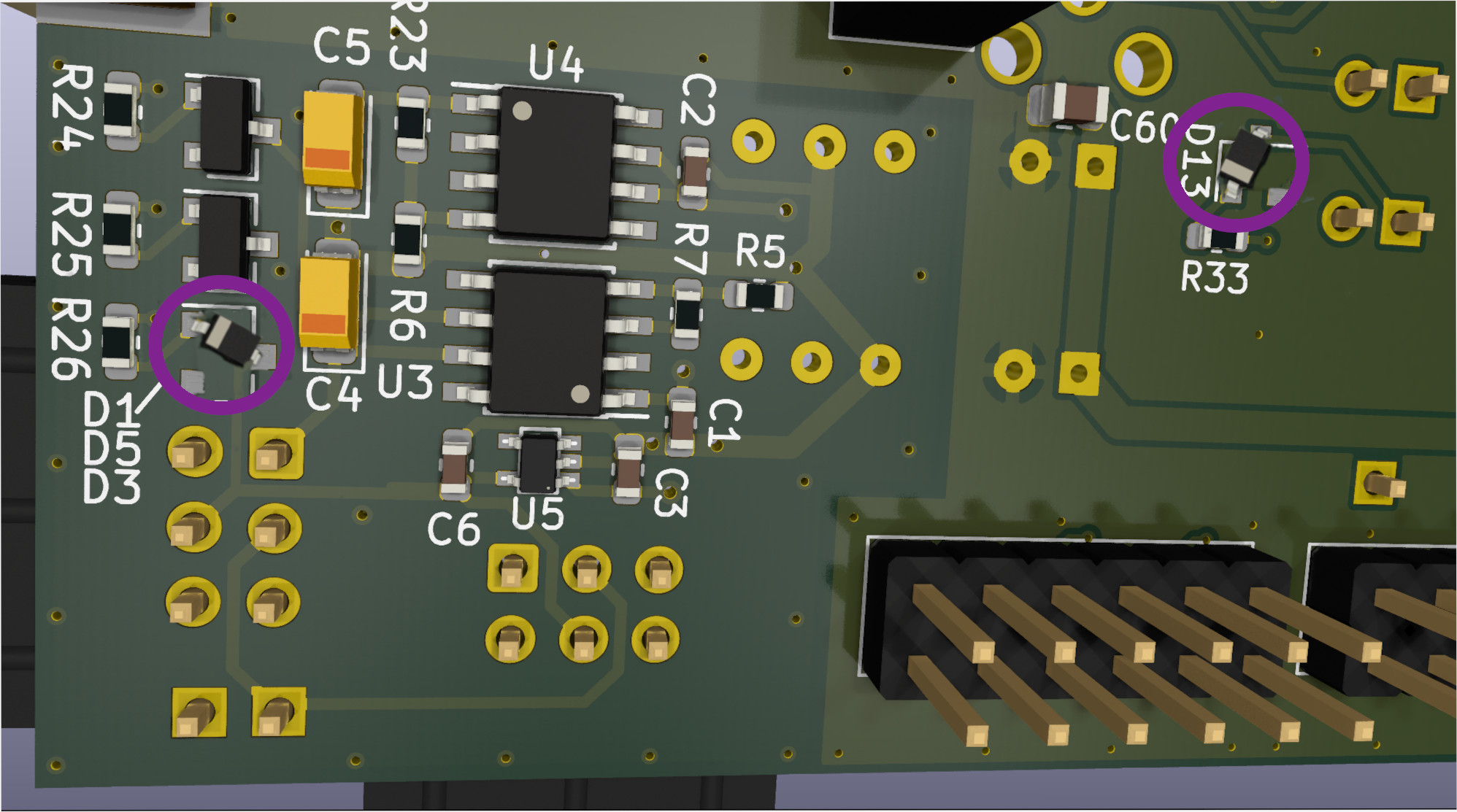3.1. FOBOS Shield
The FOBOS Shield is a circuit board developed by CERG. It connects to the Pynq board and contains:
- An implementation of OpenADC with:
A 10-bit ADC, 40MHz bandwidth, up to 105 MS/s and
An adjustable low noise amplifier.
- Power supply for the DUT with:
Three different outputs: 5V, 3.3V, and a variable output that can be programmed to supply a voltage from 0.90V to 3.65V in 0.05V steps,
Current sense monitors on all three outputs with adjustable gain in 4 steps, and
Connections to use the XADC of the Zynq chip on the Pynq board to measure voltage and current of all three outputs.
Simple crowbar glitch circuit.
20-pin Target connector to attach a DUT. This connector is ChipWhisperer compatible.
Isolated power supply providing 3.3V, -7.8V, and 7.8V which can be used to power linear and differential probes.
3.1.1. How to get a FOBOS Shield
Build one yourself. The design is fully open source and all necessary files are on github and part of the release. Building instructions are below. This might be the fastest way to get a FOBOS Shield.
If you are part of an academic research group, please ask the leader of your research group to contact Dr. Jens-Peter Kaps via e-mail to see if a FOBOS Shield can be made available to you. This might be possible depending on availability of spare FOBOS Shields in our lab, our funding situation, and time available to build new ones.
3.1.2. Printed Circuit Boards
At CERG, we use KiCad to design our printed circuit boards (PCBs). The KiCad files for the FOBOS Shields are stored in the directories:
hardware/fobos-shieldfor the FOBOS Shield that connects to a Pynq-Z1 board andhardware/fobos-shield-Z2for the FOBOS Shield that connects to a Pynq-Z2 board.
You can use KiCad to export the PCB design to any files your preferred PBC manufacturer requires.
Ready to order projects for the FOBOS Shield PCBs are also available at OSHPark :
Important
The printed circuit boards from OSHPark or your favourite PCB manufacturer do not contain any electronic components. Populating the PCB with components and soldering them are additional steps.
3.1.3. Populating the PCBs
The directories for the FOBOS Shields contain the parts lists, also called Bill or Materials or
BOM for short. At CERG, we use LibreOffice to create the BOM
and publish it as *.ods file. The filename for the BOM is fobosshield-bom.ods.
The BOM contains the schematic references of the components (e.g. R1, C5, etc.) which are also on the silk screen of the PCB, the minimum quantities, values, case code, a short description, and specification of each component. For convenience we added the part numbers that the electronic distributor Mouser uses. As the availability of components changes constantly, we cannot guarantee that all components will be available or are even still manufactured. The description and specification as well as the data sheets available on the Mouser website should be sufficient to find alternative components when needed.
You have two options to populate a PCB with components:
You order all necessary components and a few spares and solder them to the PCB yourself.
Ask your PCB manufacturer to place all components and solder them. Some PCB manufacturers will do this for all surface mount parts and then you will still have to add the through-hole components which are much easier to solder.
Important
We made an effort to use mostly use components of the size 0603 and larger whenever possible. However a few components are of the size 0402. When ordering components please make sure that you order more than the minimum because:
If a small 0603 component falls off the table, you will either never find it again, or not know which component you just found as many have no markings.
Resistors and many capacitors are significantly cheaper in quantities of 10 or 100.
Warning
The circuit for the FOBOS Shield, the PCB layout and the BOM were designed with great care. However, the FOBOS developers, the Cryptographic Engineering Research Group CERG, and George Mason University are not liable if the FOBOS Shield that you build does not work and/or causes the Pynq board to fail. FOBOS is provided on an “AS IS” BASIS, WITHOUT WARRANTIES OR CONDITIONS OF ANY KIND, either express or implied, including, without limitation, any warranties or conditions of TITLE, NON-INFRINGEMENT, MERCHANTABILITY, or FITNESS FOR A PARTICULAR PURPOSE.
3.1.4. FOBOS Shield Z1 rev 2
This shield has a small discrepancy between the published KiCad schematic and the latest version of the BOM. Zener diode D1 has a different value. Two Zener diodes (D3, D13) have been changed to small signal diodes and the value of two resistors (R26, R33) for two LEDs have been changed to make sure all LEDs illuminate equally. Below is a picture showing how to mount the small signal diodes 1N4148 in SOD-323F case on the SOT-23-3 PADs for the Zener diodes.

Fig. 3.1 Placement of D3 and D13 in SOD-323F case on SOT-23-3 pads